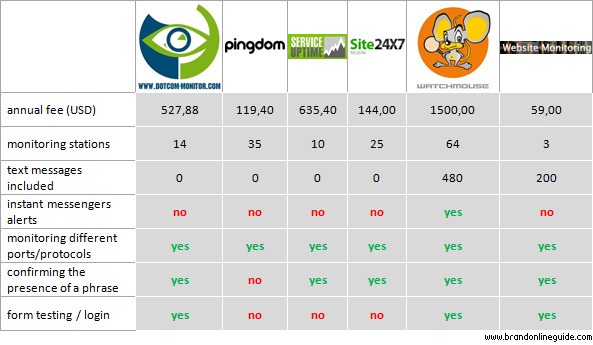Website monitoring – how and why to monitor a website?
I will start with pointing out that this article is not about tracking user traffic, but about availability monitoring, i.e. detecting and reporting website outages.
Availability monitoring
In this service a website is automatically monitored by an external pinger. The mechanism acts like a browser, visits the website every 60 seconds and checks if it functions properly. It records the server’s response (investigates if there were any errors), checks if a timeout occurred. Optionally it can also confirm the presence of a defined phrase.
In the event of encountering a failure, the system sends notifications via email and SMS, sometimes also on an instant messenger. All events are stored in a database, so one can review the history of availability as well as check the availability within a given time frame.
A failure can be credibly identified when there are 2 or 3 monitoring stations located in different regions, i.e. connected to different providers and linked to the monitored website by different routes. A single station reports a failure each time when a connection to the monitored website cannot be established. The problem may just as well lie with the monitoring station or somewhere in between, which is why a failure needs to be confirmed by other, independent stations.
Is it worth it?
I always recommend website monitoring to my customers.
Some people believe that the answer to this question depends on the traffic on a website. But even if a website is rarely accessed, it may happen that a downtime occurs during a key customer’s/potential partner’s/investor’s visit to the site. Every commercial website has a specific aim and every failure means that the aim is not being achieved.
Of course there are many situations where it is obvious and indisputable that monitoring is necessary. Some of them include:
- websites to which traffic is directed from ongoing advertising campaigns
- e-commerce websites (all sites where consumers buy goods or services on-line)
- websites offering services that are accessed using a browser (SaaS)
- extranets.
Comparison
There are a few website monitoring providers on the market. The price range is almost just as big as the difference in the quality of services. When comparing the prices and characteristics of services I took into account only suppliers who offer 1-minute monitoring. In my opinion a longer time makes website monitoring pointless.
The parameters which I considered are as follows:
Annual fee – regardless of whether it’s possible to pay on a per-month basis, an annual cost has been calculated.
Mobile text alerts included in the package – all mobile operators offer SMS notifications but some may impose additional charges for each message.
Monitoring stations – as I already explained above.
Instant messenger alerts – IM services such as Gtalk, MSN or Jabber may not be typical business tools but many webmasters use them and would appreciate the possibility of receiving alerts this way.
Monitoring of different ports – thanks to this feature not only websites can be monitored, but also mail servers, DNS servers, etc.
Confirming the presence of a given phrase – this option ensures that a given phrase is present in the code of the monitored website. This can be any part of the content or an HTML tag, e.g. “</html>” – finding which means that the entire page was loaded.
Testing forms – the possibility to fill in an Internet form using the monitoring system, e.g. logging in with a user name and password.

Providers
The most expensive provider on the list is WatchMouse – a Dutch company which offers its services in 40 countries worldwide. The world’s largest monitoring network does not justify its price, which is sometimes even 10 times higher than the price some competitors offer.
Service Uptime and dotcom-monitor.com are 2 times cheaper, yet still relatively expensive. Both have a similar offer in terms of basic monitoring, but dotcom-monitor.com also provides more advanced services.
Some companies which fall into the next price level are Pingdom from Sweden and site24x7. The latter belongs to ZOHO, a company which offers probably the widest range of online business applications on the market.
In terms of price, the winner of this comparison is SuperMonitoring.com, whose quality of services and offer are just as good as those offered by the remaining companies.
Hosting and SLA
Let’s not be deluded and believe that all web hosting providers are honest enough to inform us about every single outage, even the smallest one, and then present the actual level of services they performed at the end of each month. Of course I wish this to everyone. But at the same time it is much safer to use independent monitoring and compare the uptime with the data we receive from our hosting provider.